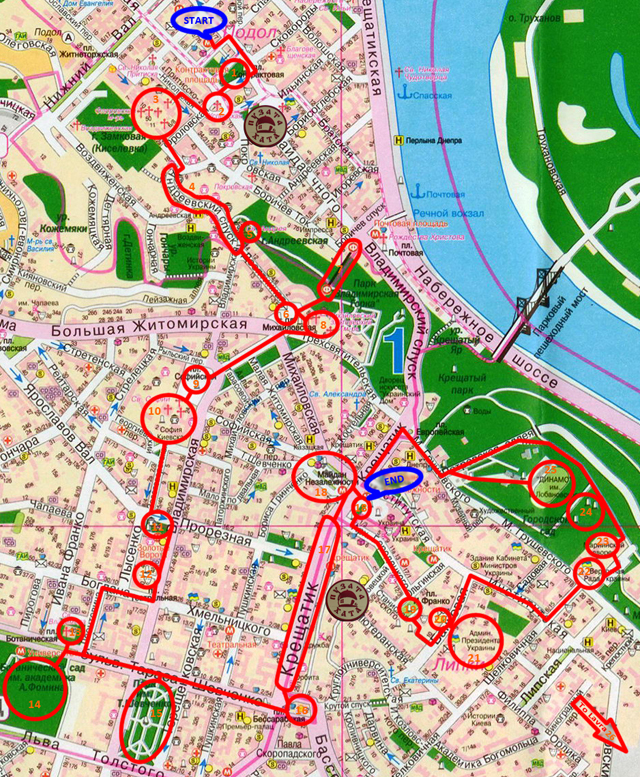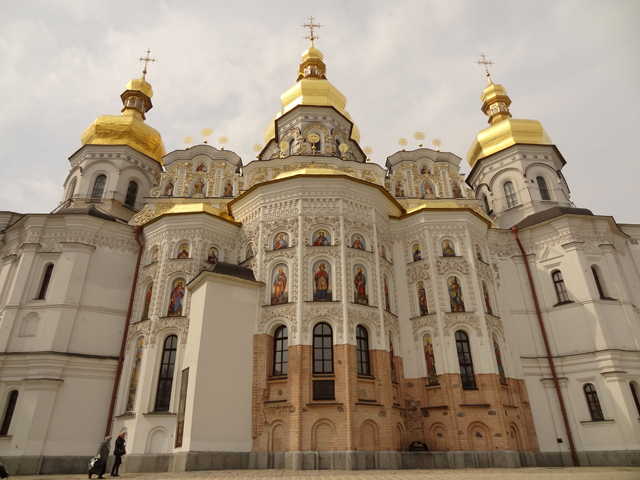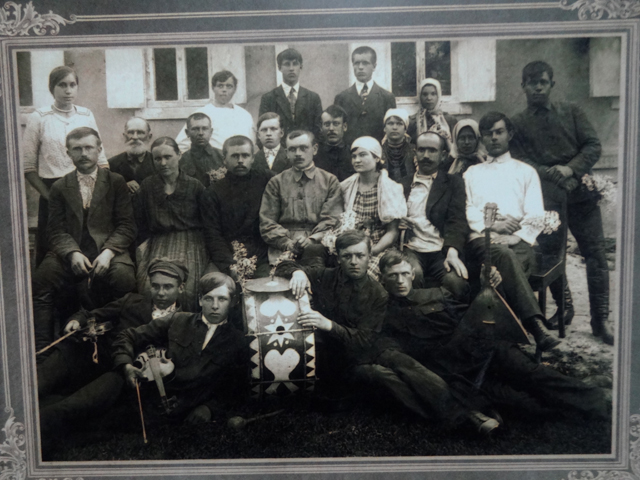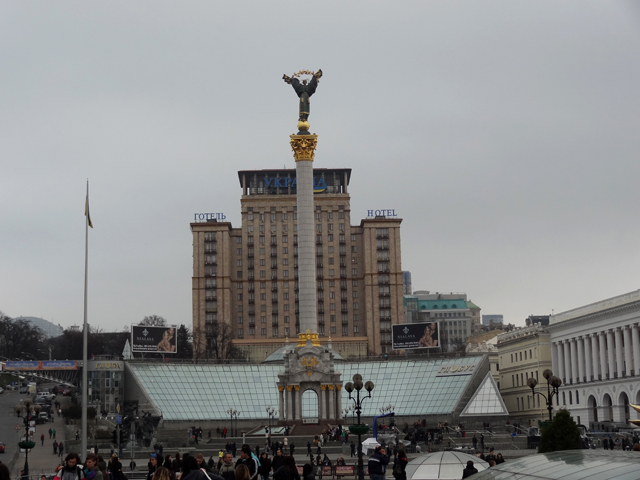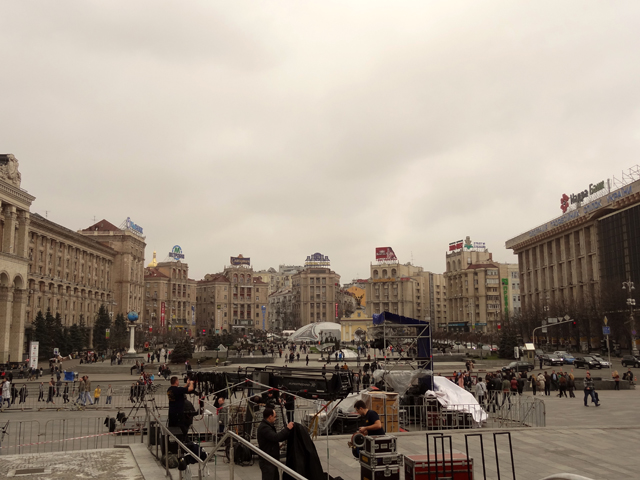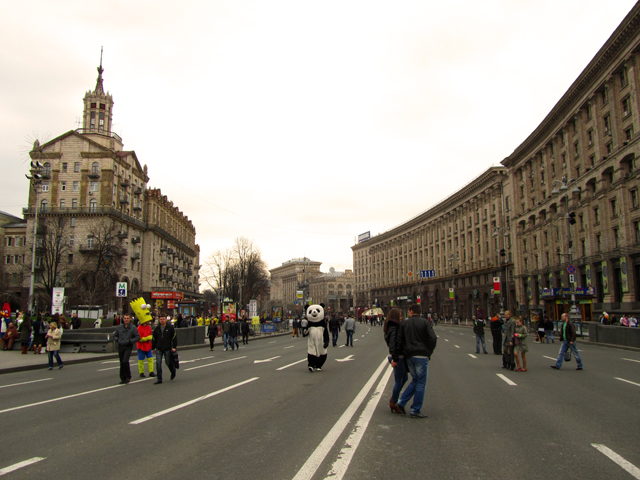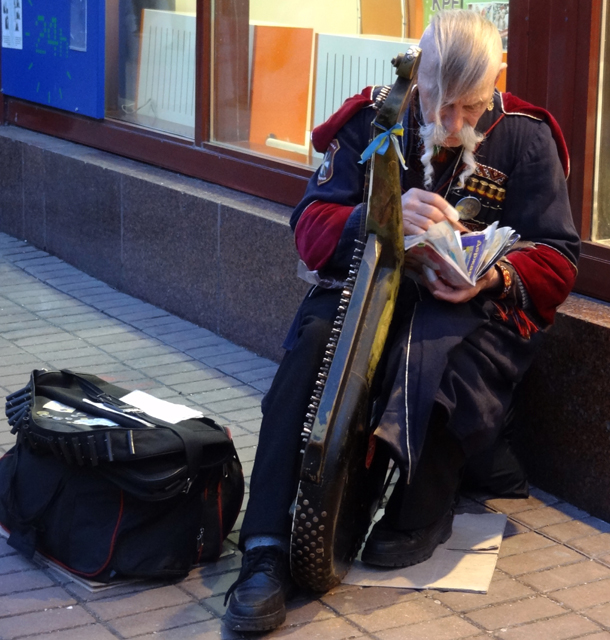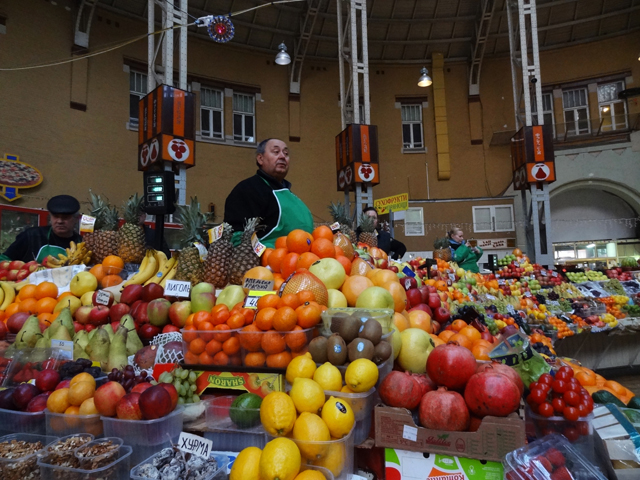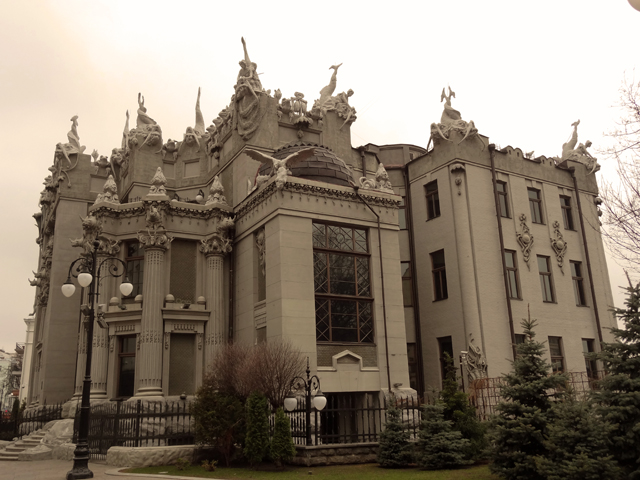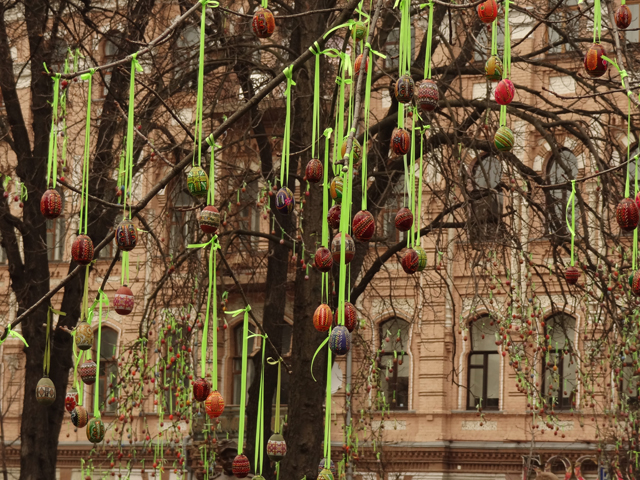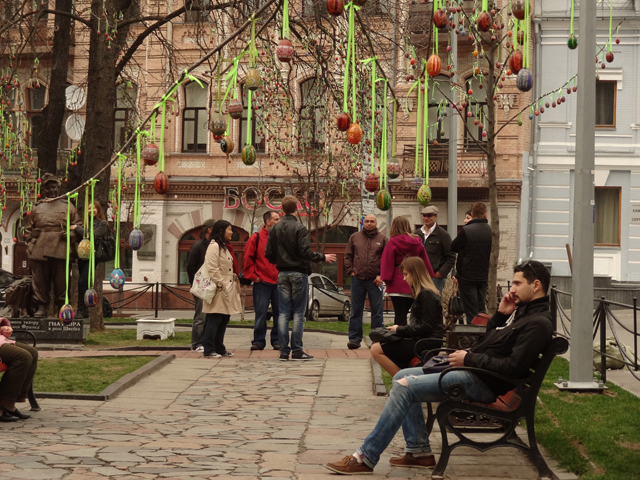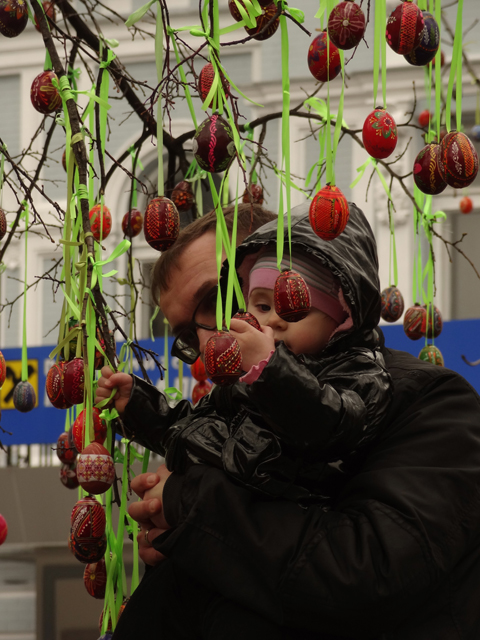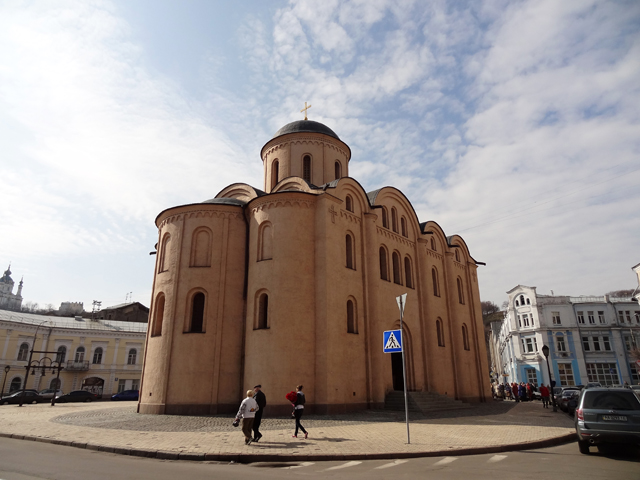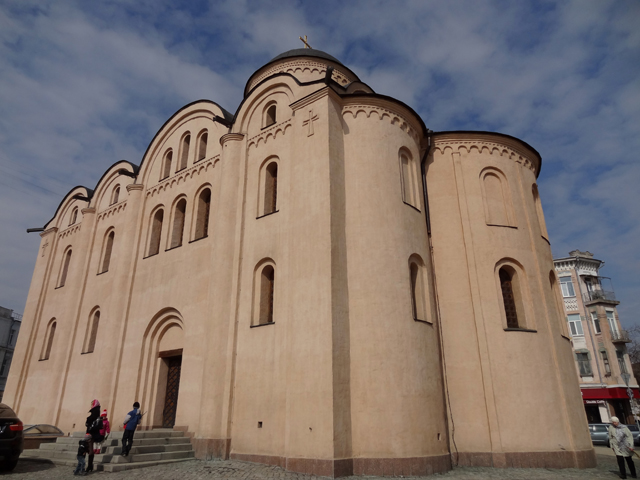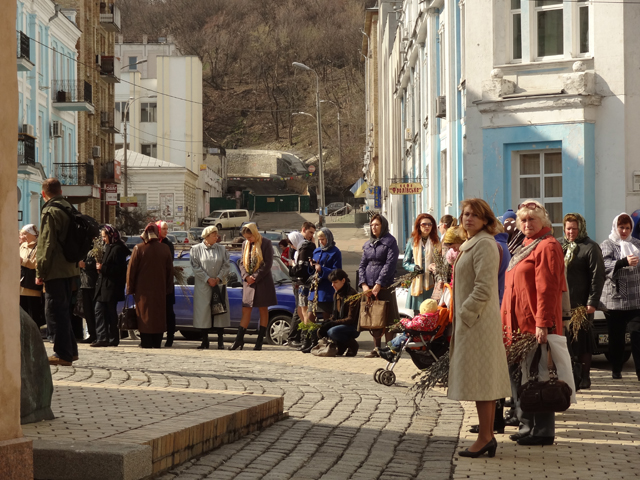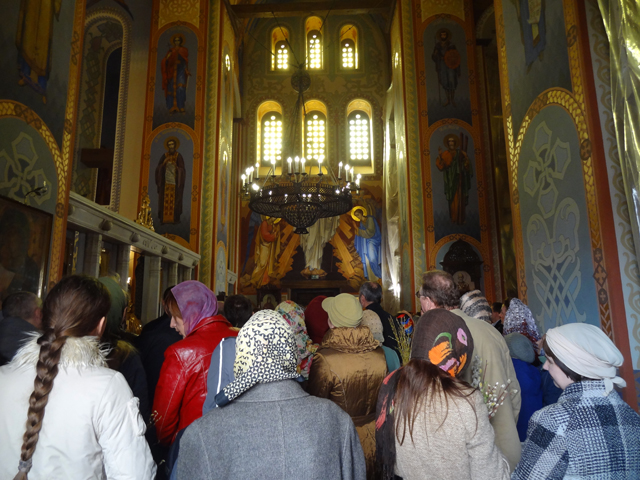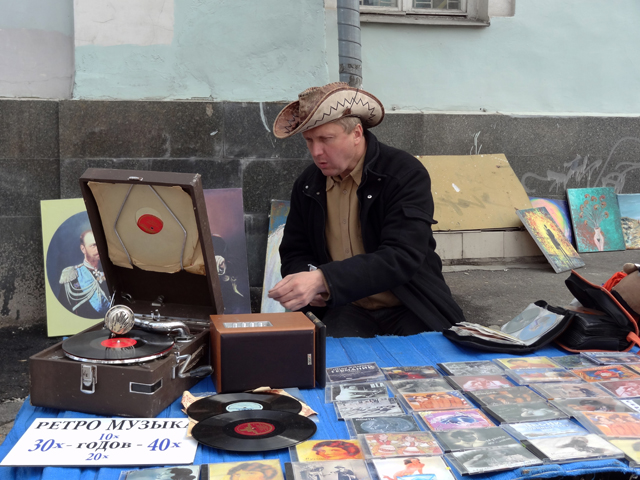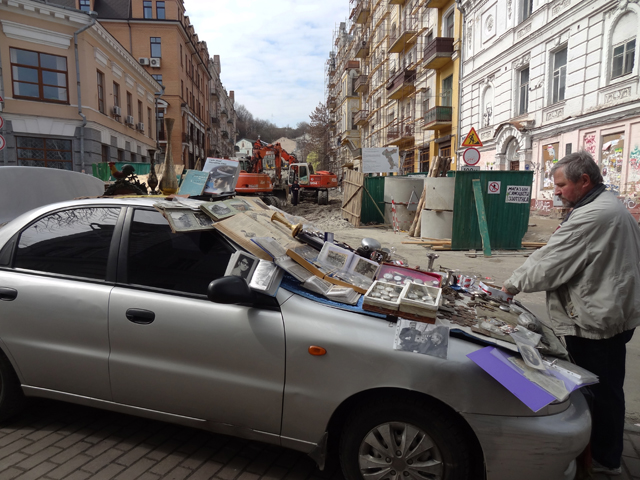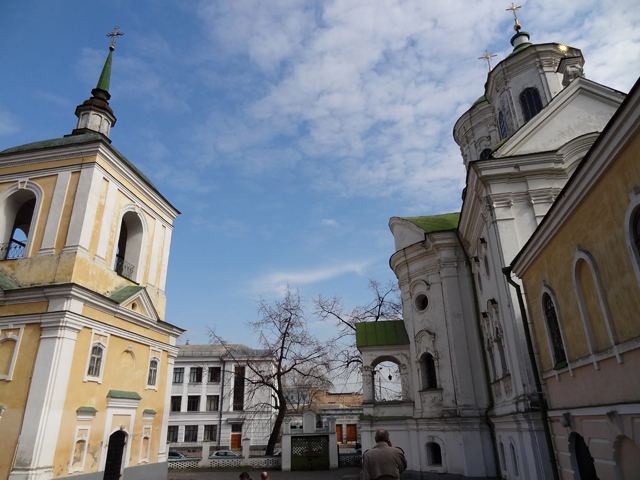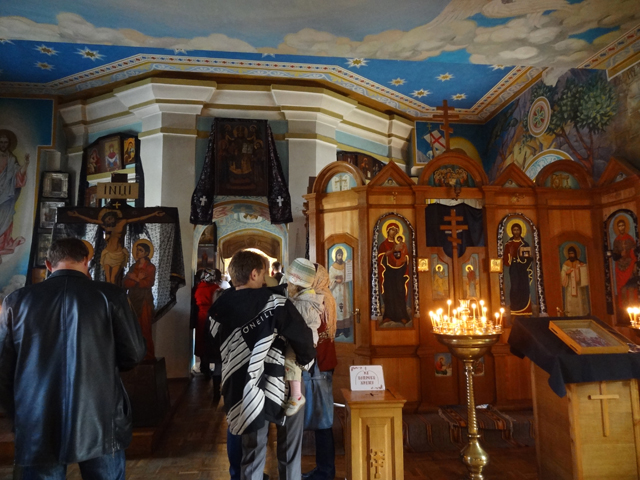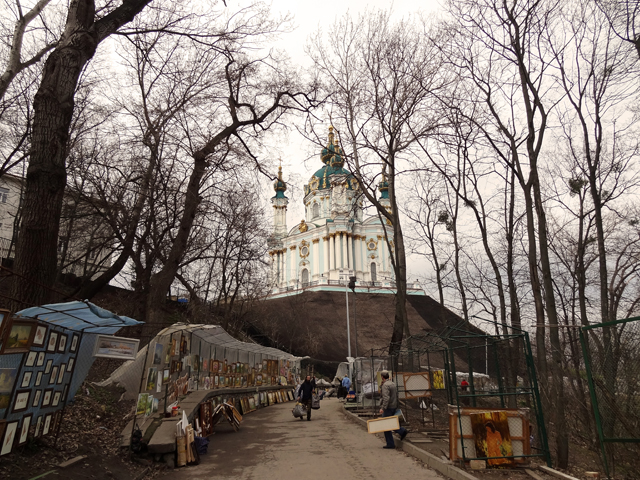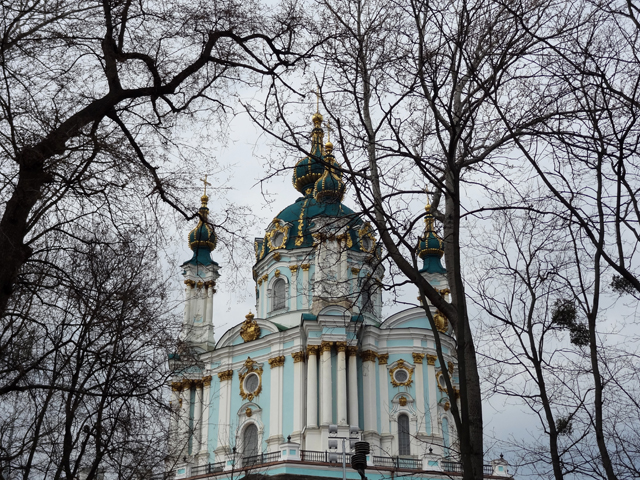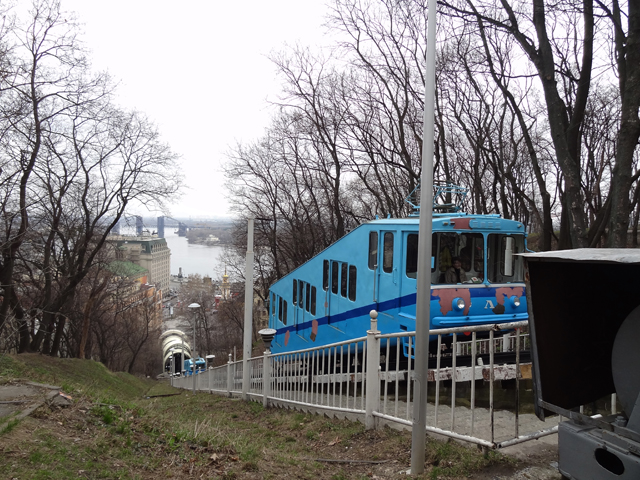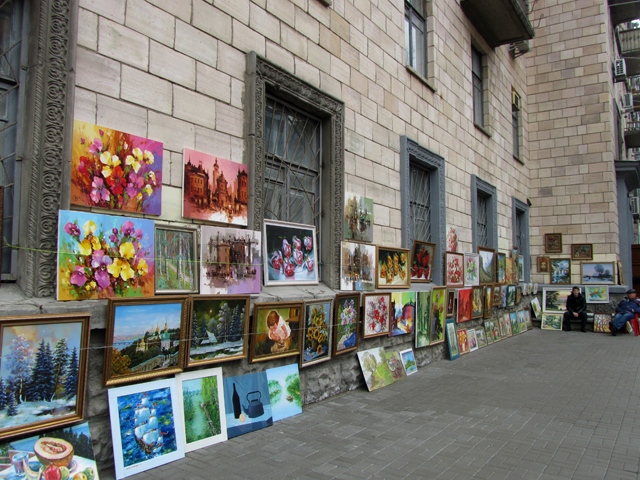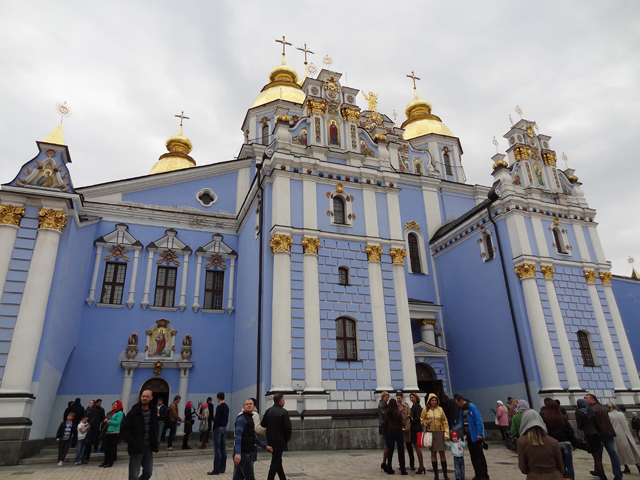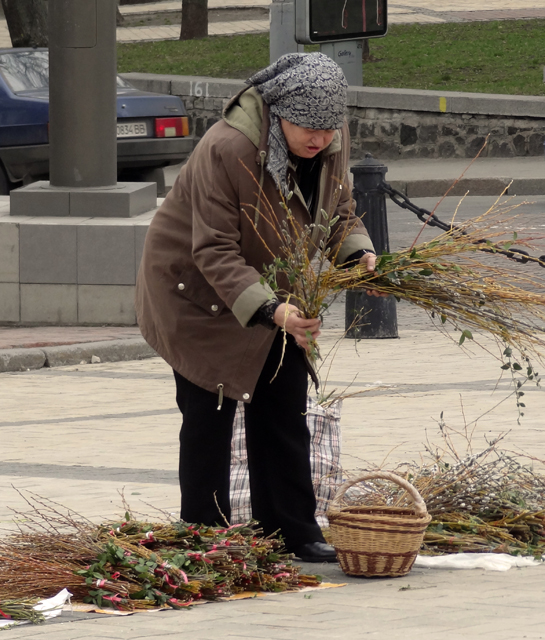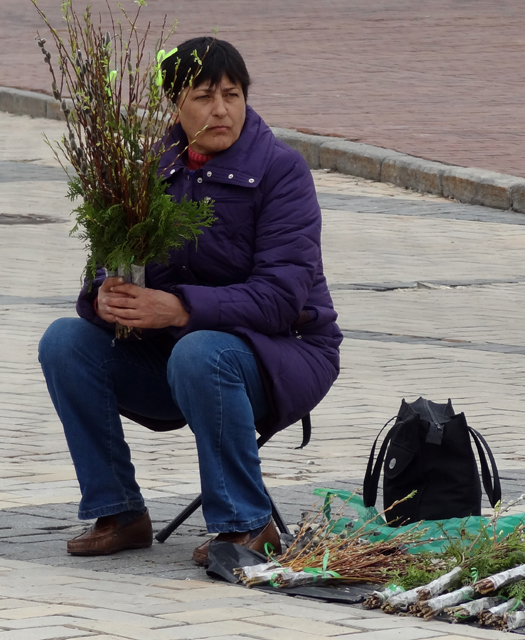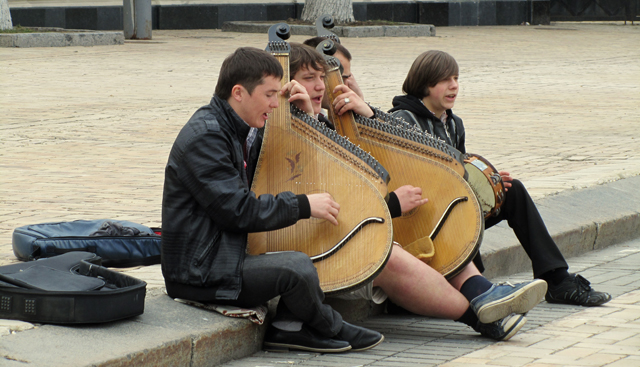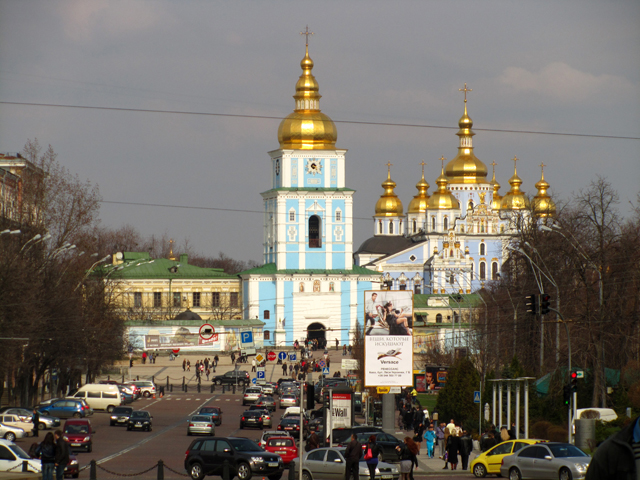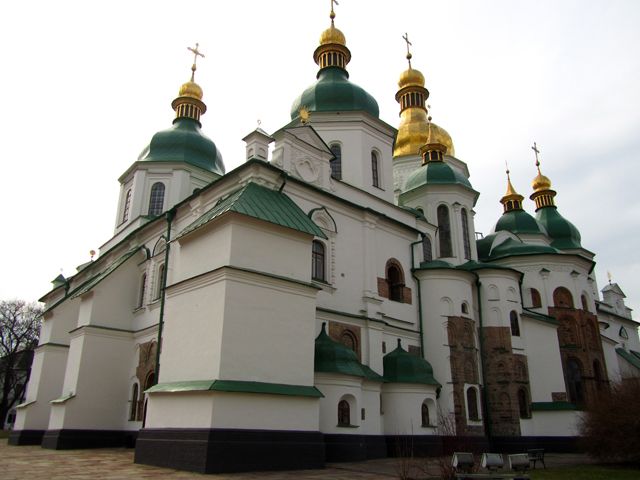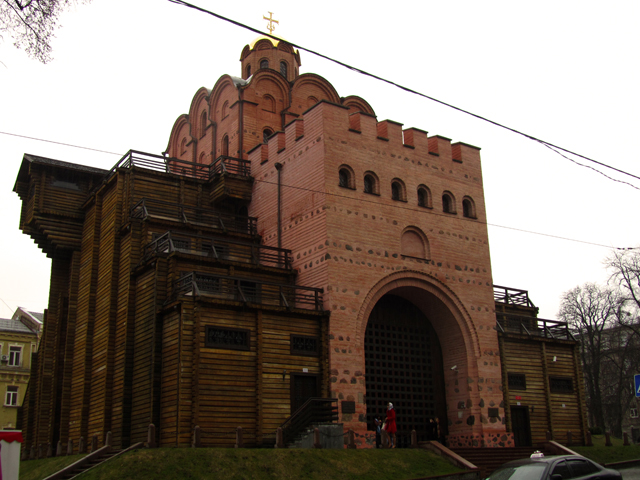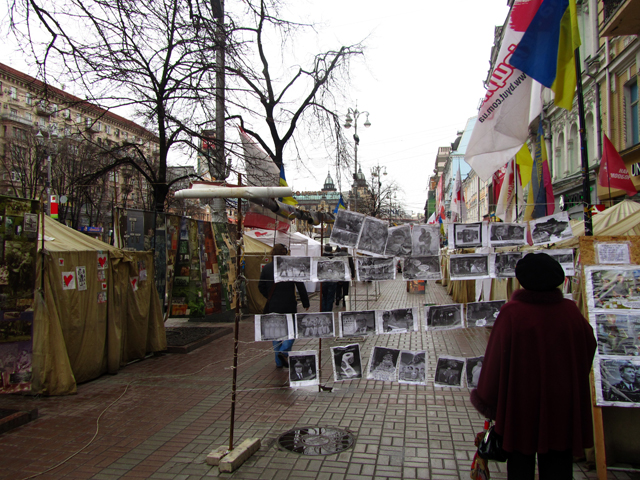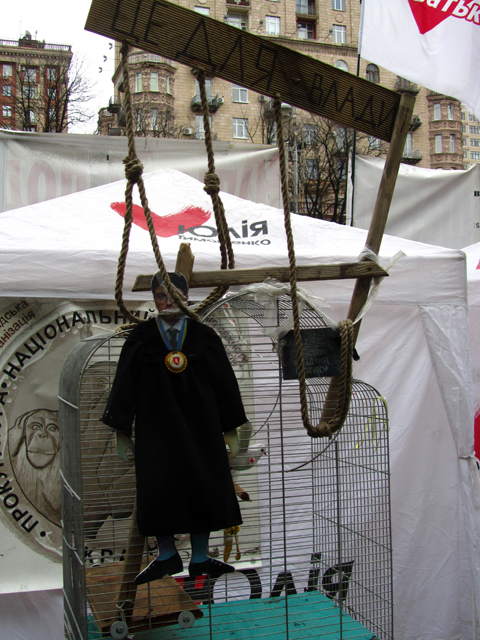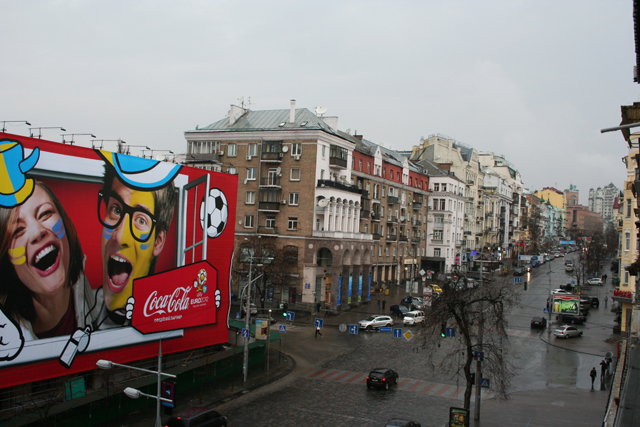Kiev - walking tour and practical tips
During our stay in Belarus we took a 4-day trip to Kiev. I've always loved this city and at some stage even lived there for a couple of months. It definitely has a very special look compared to any ex-Soviet capital, first, due to the distinctive charm all the hilly cities on a river bank have and second, because it doesn't look Soviet. Although the best time to visit Kiev is definitely summer, April is not so bad either, mainly because it's so much easier to rent a flat (the best and cheapest accommodation option in any ex-Soviet capital) and at the same time the days are gradually getting warmer.
Although Kiev is quite big, all its major sightseeing attractions can be combined into a one-day walking tour and another half a day is needed to visit the Pechersk Lavra (its most prominent and truly beautiful monastery). If you have more time, then the one-day tour can be split into two quieter-paced ones and the rest of the time filled with return visits to the places you loved most, to really let Kiev get into your system.
The walking tour:
Since Kiev is getting ready to meet the champions and their fans this summer during the EURO CUP 2012, just in case any of you are going to join the cheering crowds (not a bad idea as Kiev is an excellent and definitely inexpensive place to have a lot of fun), we made a map of a possible route for a one-day Kiev walking tour. We put the route on top of the tourist map of Kiev centre we found at the Russian resource http://capone-online.ru. Click on the map for a larger version.
This route starts in Podol (a trully picturesque area of Kiev), at the metro station (1) Kontraktova Square, then passes through the (2) Church (Tserkov') Bogoroditsy Pirogoschey and the (3) Frolov monastery, then climbs up the most beautiful street of Kiev - (4) Andreevskiy Spusk - up to its cutest church - (5) Andreevskaya Tserkov', which offers awesome views of Kiev.
After that the route continues via Desyatinnaya street to the (6) Mihailovskaya Square which gives access to two attractions - the (7) Funicular and the gorgeous blue (8) Mihailovskiy Zlatoverhiy (literally, "gold-headed") Monastery. From Mihailovskiy monastery the route goes down to the (9) Sofiyskaya Square from which you can access modern Kiev's oldest and very important church (and a UNESCO heritage) - (10) Sofiyskiy Sobor. This Sobor played a very important role in Vyalikaya Rus' (the Great Russia) - an ancient state which was first mentioned in the scriptures in the 9th century and is believed to be the origin of Rus'. At its best times (of least feudal disputes and maximum unity) Vyalikaya Rus' included the territories of modern Russia, Ukraine and Belarus, with Kiev as its capital. Therefore it's no coincidence that there are 3 churches in the world that are called Sofiskiy Sobor - one in Kiev (Ukraine), one in Novgorod (Russia) and one in Polotsk (Belarus). Kievskaya Sofiya was built by Prince (knyaz') Yaroslav the Wise to celebrate his victory over the pagan pecheneg people. At that time (in the 11th century) Kiev had more than 900 churches (the Sofiyskiy Sobor is the only one that survived to these days). On the premises of Sofiyskiy Sobor you can visit the House of Metropolitan (an Orthodox counterpart of a Catholic bishop).
From Sofiyskiy Sobor if it's lunch time, the best way to have a good and non-expensive meal would be to make a detour via Sofiyskaya Street to (17) Kreschatik (Kiev's main street) and look for Puzata Hata (more on this Ukranian food chain below in the food section). This detour passes through (18) Maidan Nezalezhnasti - the Independence (which is of course the main) Square of Kiev.
With or without this lunch detour, the main tour continues from the Sofiyskiy Sobor down via Vladimirksaya or the parallel smaller Zlatovorotskaya (= Golden Gate) street down to naturally the (11) Golden Gate (which used to be the main gate of the wall around the ancient Kiev city). From the Golden Gate it's just a short walk to one of the architectural highlights of Kiev - its (12) Opera and Ballet Theatre. Then the route goes a little more down passing through one more church - (13) Vladimirskaya Tserkov'. Since by this time anybody would be saturated with churches, this is luckily the last one in the highlights route.
Now the route turns to the east to take you via two parks (which in summer both are a really nice place to rest your tired feet) - the (14) Botanical Garden and (15) Shevchenko Park (named after Ukraine's most famous poet) - to (17) Kreschatik (like I said before, the main street of Kiev). Following Shevchenko Street till Kreschatik you'll first see a big yellow building - that's the (16) Bessarabskiy Market. After checking out all sorts of curious preserves and other delicacies sold mainly to tourists at this purely touristic market, join the crowds of locals, tourists and pilgrims strolling through (17) Kreschatik, if possible adopting the pace of locals, for whom Kreschatik is the favourite hang-out spot (they come here to meet dates, friends and strangers, do orange revolutions etc. and never hurry to leave).
After tasting ice-creams and buying magnets, taking all the photos and possibly making friends with locals, it's time to remember you still have some walking to do, so start walking through the last area of this highlights tour. From the prominent (18) Maidan Stella, take the small Gorodetskogo street to the south-east of Maidan till you find a small (19) park at the Franko Square. Follow the stairs that lead from this park up to the Bankovaya Street where you'll find two highlights: the (21) Building of the Ukranian President's Administration and the striking (20) Himera (Chimera) House. There are many theories regarding the inspiration behind the weirdish look of this latter building but the one that struck me as plausible was that the whimsical magnate and architect wanna-be Horodetskiy who built it was simply trying to promote his friend's cement factory. At that time cement was a new material in the construction industry, and Horodetskiy used it extensively to create all those animals and ogres which give the Chimera House its name.
Leave the creatures behind and continue via the same Bankovaya Street up to the crossing with Institutskaya Street, turn right and walk (past a prominent building of the National Bank) till the second crossing. Turn left this time and you'll find the Building of the so-called (22) Verhovnaya Rada of Ukraine - the country's parliament. Right next to it you'll find the (23) Mariinskiy Palace, and right behind the palace - the (24) City park and the (25) Dinamo Stadium. The route finishes back at (17) Kreschatik so walk down back to (18) Maidan - for more hanging out or to take the metro to wherever it is that you rented the flat. That's the end of this walking tour!
Pecherskaya Lavra:
Apart from all the highlights combined into the above long walk, when in Kiev you should definitely visit the Pecherskaya Lavra. To reach it, just take the metro to the Arsenal'naya station, and then either take trolleybus 38 or walk for just 2 stops (ask locals for Pecherskaya Lavra to get the right direction) till you find the entrance to the Lavra. Plan about half a day, since Lavra stretches over quite a big territory and during your visit there you can see several old and beautiful churches (including the Uspenskiy Sobor), as well as two locations (the close "Blizhnie" and the far "Dal'nie") of the ancient caves (cave = "peschera", or its old version "pechera" - hence the name Pecherskaya). These caves is what Lavra started from, when in the 11th century an Orthodox monk Antoniy dug a cave at the Berestov mountain that overlooked the Dnepr river in order to live there in an Orthodox monastic way. This became what is today known as the "close" caves. He was later joined by many more monks and digging continued at the "far" location. Prince (or more precisely knyaz' - the ancient Russia's royal title) Izyaslav of the Great Russia (Vyalikaya Rus') was so struck by the monks' religious fever that he gave them the whole mountain as a gift. The churches and the brick-and-mortar monastery were built over the years and after a while Pechersk monastery reached such prominence in Vyalikaya Rus' that it was granted the name Lavra - a Russian word for a very important church/monastery.
These days the caves of Pecherskaya Lavra hold the bodies of many important Orthodox church figures, saints and legendary people (one of them for instance is a fabled ancient hero - bogatyr' Ilya Muromets (kind of local Hercules). Deeply religious local people on a visit to the caves stop at every single one of the glass caskets to get a blessing from the saints by touching the glass with their lips and foreheads. A visit to the caves supposedly cleanses the person of all the sins. There are even occassional exorcism procedures performed here by trained Orthodox priests. Religious people from all over the former USSR come to Lavra to get healed, baptise children, ask the saints for help in specific affairs. One of the healing miracles of the caves are the so-called Mirotochivye Glavy (human heads that produce oily substance) located in the small underground churches in the caves. The miracle about them is that according to the chemical composition the substance they produce can only originate in a living body!
The Chernobyl Museum:
Apart from Lavra, on a trip to Kiev, you might consider visiting the Chernobyl Museum (Metro station Kontraktova Square - exactly the start of our walking tour). We did it on our last and the only rainy day in Kiev and it was definitely worth it. It's a great place to learn more about the most horrible nuclear disaster in the history of the human race, but you will either need to take an audio guide (we've been told by a couple of backpackers that it was quite ok) or, like in our case, follow a guided tour (in our case we simply joined the Russian-language tour for school children which was conducted by the best guide I've ever seen, but we also saw people with Engish-speaking guides). This museum is definitely a much cheaper alternative (a couple of dollar vs 150-200) to the Chernobyl Tour, and information-wise might be even better value for money. (And here is our post with some facts on Chernobyl and the Chernobyl tour that Jordi took during our trip to Kiev.)
Practical tips:
Finally, for those who were not born in the USSR and are daring enough to visit Kiev, here are some more practical tips from me (a Belarusian girl):
1) Accommodation: the best accommodation option in Kiev is to rent a flat, especially if you are two or more. Prices for 1-room apartments within the 2-metro-stop radius from Maidan are about 40-50 USD, and 50-100 USD for 2-room apartments. It's cheaper for farther metro stations. Prices will definitely go up in summer, but it's still a much better alternative to Soviet hotels or hostels (that's not where a local would stay). These days some rental agencies have an English page and I hope even more will do the translation by summer. We used http://apartments-center.kiev.ua, +38 (067) 407-52-62 and +38 (067) 765-62-67 (mobile), +38 (044) 361-04-54.
2) City transport: Kiev metro will bring you to most of the sights you need to go, as well as to the bus stations and partially to the airport. Apart from being convenient and cheap, it's also an attraction in itself, as some of its stations are the deepest metro stations in the world! For the Borispol' airport, go to the Har'kovskaya metro station (on the green line), and there go up to the street and wait for the airport bus (ask people for its exact location and ignore the taxi drivers). The airport bus goes quite often in the mornings. The same route can be easily done in the opposite direction.
3) Food: ever since my friends from Kiev showed it to me on my first visit to the city, I stick to eating in Puzata Hata - a kind of wholesome fastfood chain that serves Ukraniane food in a buffet manner. On the map we marked two of the Puzata Hata places (one is right on Kreschatik). Here is what to do when you go to one: find your way in, have a look at the dishes served in a buffet-like manner, make up your mind which ones you like (there are always several soups, starters, main dishes etc.), then take a tray and just point at the dishes you chose to the serving lady/guy. When you are done with taking all your plates, go to the cashier's, pay (relatively little compared to other Kiev restaurants) and enjoy your meal. Finally, make sure to try the Ukrainian specialty - vareniki (kind of local dumplings) - Puzata Hata always serves several versions: with potato, cabbage, cherry and more.
3) Going out: Kiev is no different from any other ex-Soviet capitals in terms of going out, in the sense that people usually go to discos to have a night of fun. The thing is that there's no area where you could simply find all the discos, so the best way to do it would be to ask a local person which discos they like: not all of the places have a nice vibe, so if you just pick it randomly, you might pay an expensive entry ticket for a place you don't really like and (because the locals don't really like it either) will be the only one on the dance floor.
Well, if anyone is going to Kiev this summer, let us know if there's anything else you'd like to know which we overlooked - we might have the insider information :-).
Below are some photos from our trip to Kiev:
Kievo-Pecherskaya Lavra (26):
Uspenskiy Sobor in Kievo-Pecherskaya Lavra:
Museum of Holodomor ("Killing by hunger") - the man-made famine in the Ukranian SSR in 1932 - is located very close to the Pecherskaya Lavra. The statue of the girl pressing an ear of wheat to her chest symbolizes all the kids who were shot on the spot for trying to pick up the tiny bit of wheat which was left in the fields after the whole crop was taken to Russia in order to deliberately starve Ukranians to death during this horrifying genocide action of the Soviet government against the "stubborn" republic:
Maidan Square (18):
Bessarabskiy Market (16):
Chimera House (20):
This park at the Franko Square (19) was decorated with hundreds of easter eggs at the time of our visit:
The Building of President's Administration (21):
Tserkov' Bogoroditsy Pirogoschey (2):
It was the Palm Sunday during the time of our visit so all the locals where attending the special festival services to get their pussy-willow brunches sprinkled with holy water:
"Retro" items, antiques and souvenirs at the stolls around Kontraktova Square (1):
Frolov Monastery (3):
Unfortunately, this was the state of Kiev's most beautiful street - Andreevskiy Spusk (4) - during our visit. This was due to the reconstruction work they were performing to prepare the street for this summer. Since Andreevskiy Spusk was closed, we had to climb up a hill directly beneath the Anreevskaya Church (5)to access it, and then take the street parallel to Spusk, where we found all the local artists who temporarily moved there from Andreevskiy Spusk:
Andreevskaya Church (5):
Funicular (7) and another arts street around Andreevskaya Church:
Mihailovskiy Zlatoverhiy Monastery (8):
Women selling pussy-willow brunches at the Mihaylovskaya Square (6):
These guys were really good performing the traditional Ukranian songs at the Sofiyskaya Square (9):
The view over Mihailovskiy Zlatoverhiy Monastery from the Sofiyskaya Square:
Sofiyskiy Sobor (10):
The Golden Gate (11) and Vladimirskaya Church (13):
Election campaign at Kreschatik (17) is a kind of "humour tour". Here's were witty Ukranians can freely express their opinions about competitors and all sorts of other political issues (note how Timoshenko's supporters expressed their sentiments towards her judge):
On the left the view (at the huge Eurocup 2012 poster) from our rented apartment at the Krasnoarmeyskaya Street; on the right - inside a Puzata Hata restaurant:
